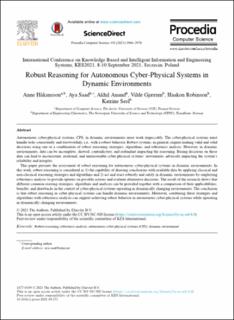| dc.description.abstract | Autonomous cyber-physical systems, CPS, in dynamic environments must work impeccably. The cyber-physical systems must handle tasks consistently and trustworthily, i.e., with a robust behavior. Robust systems, in general, require making valid and solid decisions using one or a combination of robust reasoning strategies, algorithms, and robustness analysis. However, in dynamic environments, data can be incomplete, skewed, contradictory, and redundant impacting the reasoning. Basing decisions on these data can lead to inconsistent, irrational, and unreasonable cyber-physical systems' movements, adversely impacting the system’s reliability and integrity. This paper presents the assessment of robust reasoning for autonomous cyber-physical systems in dynamic environments. In this work, robust reasoning is considered as 1) the capability of drawing conclusions with available data by applying classical and non-classical reasoning strategies and algorithms and 2) act and react robustly and safely in dynamic environments by employing robustness analysis to provide options on possible actions and evaluate alternative decisions. The result of the research shows that different common existing strategies, algorithms and analyses can be provided together with a comparison of their applicabilities, benefits, and drawbacks in the context of cyber-physical systems operating in dynamically changing environments. The conclusion is that robust reasoning in cyber-physical systems can handle dynamic environments. Moreover, combining these strategies and algorithms with robustness analysis can support achieving robust behavior in autonomous cyber-physical systems while operating in dynamically changing environments. | en_US |

